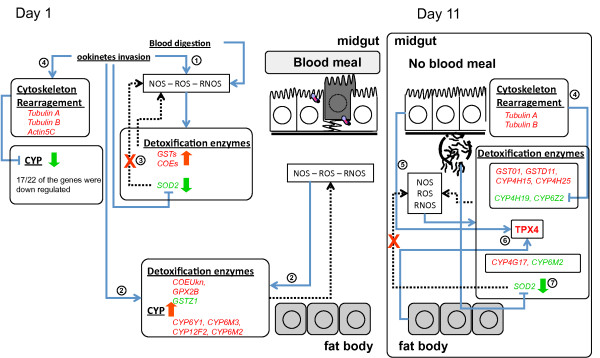Figure 3.
Hypothetical scenario of Anopheles gambiae detoxification response to Plasmodium berghei infection. Midgut and fat body genes up-regulated (red) and down-regulated (green) after infection at 2 different time points, day 1 (invasion of midgut epithelium by ookinetes) and day 11 (sporozoite egress from oocysts), and between the two events. At day 1, blood digestion and parasite invasion cause an increase in the ROS and RNOS that consequently increases the expression of detoxification enzymes (1). The parasite invasion and the ROS and RNOS also affect the fat body increasing the expression of detoxification enzymes in this tissue (2). At the same time midgut cells in response to parasite invasion suppresses the SOD expression (3) as a mechanism to eliminate parasites. Parasite invasion of midgut epithelium causes a massive cytoskeleton rearrangement that down regulates CYPs expression (4). On day 11, there is no blood digestion, but oocysts burst and sporozoites are released to the hemolymph. In the midgut the oocysts burst provokes a cytoskeleton rearrangement (4), as in day 1, that probably also down regulates CYPs expression in the midgut. While in the hemolymph sporozoites cause an increase in the ROS and RNOS that increase the detoxification enzymes expression in both midgut and fat body (5). Here, both midgut and fat body altered the expression of TPX4 (6), that is essential for hydrogen peroxide detoxification through the thioredoxin system. In the fat body sporozoites also provoke suppression of SOD expression (7).

